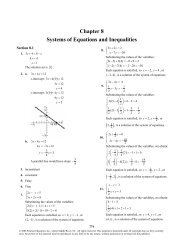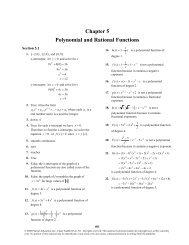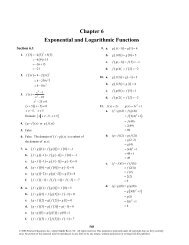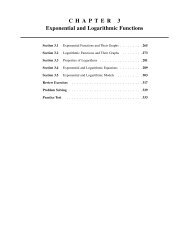C H A P T E R 2 Polynomial and Rational Functions
C H A P T E R 2 Polynomial and Rational Functions
C H A P T E R 2 Polynomial and Rational Functions
You also want an ePaper? Increase the reach of your titles
YUMPU automatically turns print PDFs into web optimized ePapers that Google loves.
258 Chapter 2 <strong>Polynomial</strong> <strong>and</strong> <strong>Rational</strong> <strong>Functions</strong><br />
151. The maximum (or minimum) value of a quadratic<br />
function is located at its graph’s vertex. To find the<br />
vertex, either write the equation in st<strong>and</strong>ard form or<br />
use the formula<br />
1.<br />
<br />
fx ax 3 bx 2 cx d<br />
x k) ax3 bx2 ax<br />
cx d<br />
2 ak bx ak2 bk c<br />
ax 3 akx 2<br />
ak bx 2 cx<br />
ak bx 2 ak 2 bkx<br />
ak 2 bk cx d<br />
ak 2 bk cx ak 3 bk 2 ck<br />
ak 3 bk 2 ck d<br />
Thus, <strong>and</strong><br />
Since the remainder r ak f k r.<br />
3 bk2 f k ak ck d,<br />
3 bk2 f x ax<br />
ck d.<br />
3 bx2 cx d x kax2 ak bx ak2 bx c ak3 bk2 ck d<br />
2. (a)<br />
b b<br />
, f <br />
2a 2a .<br />
If the leading coefficient is positive, the vertex is a<br />
minimum. If the leading coefficient is negative, the<br />
vertex is a maximum.<br />
Problem Solving for Chapter 2<br />
(b)<br />
(c)<br />
y<br />
y 3 y 2<br />
1 2<br />
2 12<br />
3 36<br />
4 80<br />
5 150<br />
6 252<br />
7 392<br />
8 576<br />
9 810<br />
10 1100<br />
x<br />
2 3<br />
x<br />
2 2<br />
36 ⇒ x<br />
1<br />
8<br />
3 ⇒ x 6<br />
2 x3 1<br />
8 2x2 1<br />
8 288<br />
x3 2x2 288; a 1, b 2 ⇒ a2<br />
x<br />
1<br />
<br />
b3 8<br />
3 x2 252 ⇒ x 6<br />
152. Answers will vary. Sample answer:<br />
<strong>Polynomial</strong>s of degree n > 0<br />
with real coefficients can<br />
be written as the product of linear <strong>and</strong> quadratic factors<br />
with real coefficients, where the quadratic factors have<br />
no real zeros.<br />
153. An asymptote of a graph is a line to which the graph becomes arbitrarily close as x increases or decreases without bound.<br />
(d)<br />
(e)<br />
(f)<br />
(g)<br />
Setting the factors equal to zero <strong>and</strong> solving for the<br />
variable can find the zeros of a polynomial function.<br />
To solve an equation is to find all the values of the<br />
variable for which the equation is true.<br />
3x3 x2 90; a 3, b 1 ⇒ a2<br />
b3 9<br />
93x 3 9x 2 990<br />
3x 3 3x 2 810 ⇒ 3x 9 ⇒ x 3<br />
2x3 5x2 2500; a 2, b 5 ⇒ a2 4<br />
b3 <br />
125<br />
4<br />
125 2x3 4<br />
125 5x2 4<br />
125 2500<br />
2x<br />
5 3<br />
2x<br />
5 2<br />
80 ⇒ 2x<br />
4 ⇒ x 10<br />
5<br />
7x3 6x2 1728; a 7, b 6 ⇒ a2 49<br />
<br />
b3 216<br />
49<br />
216 7x3 49<br />
216 6x2 49<br />
216 1728<br />
7x<br />
6 3<br />
7x<br />
6 2<br />
392 ⇒ 7x<br />
7 ⇒ x 6<br />
6<br />
10x3 3x2 297; a 10, b 3 ⇒ a2 100<br />
<br />
b3 27<br />
100<br />
27 10x3 100<br />
27 3x2 100<br />
27 297<br />
10x<br />
3 3<br />
10x<br />
3 2<br />
1100 ⇒ 10x<br />
10 ⇒ x 3<br />
3
















